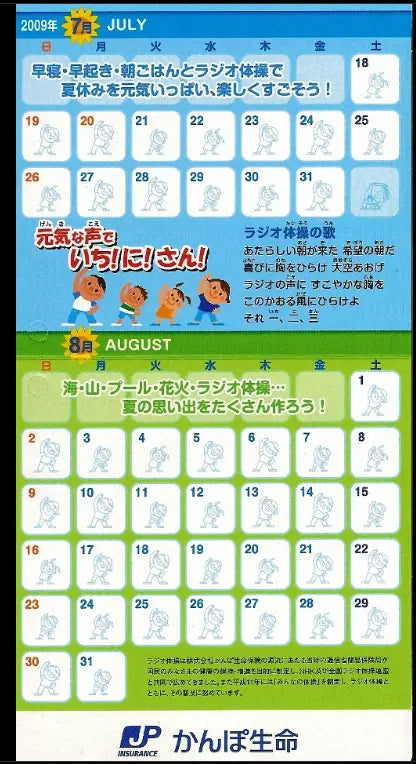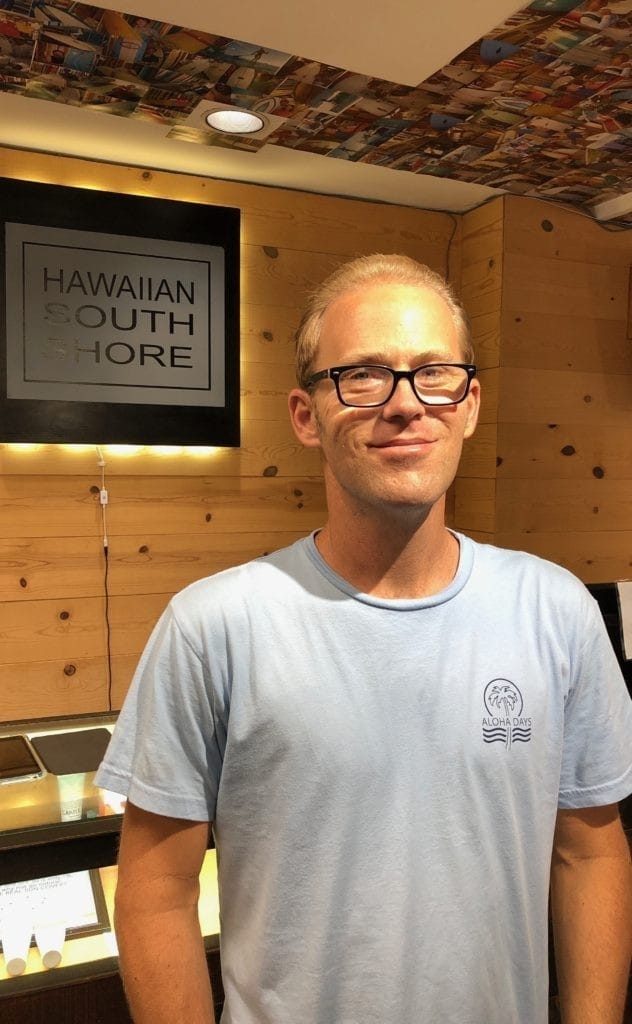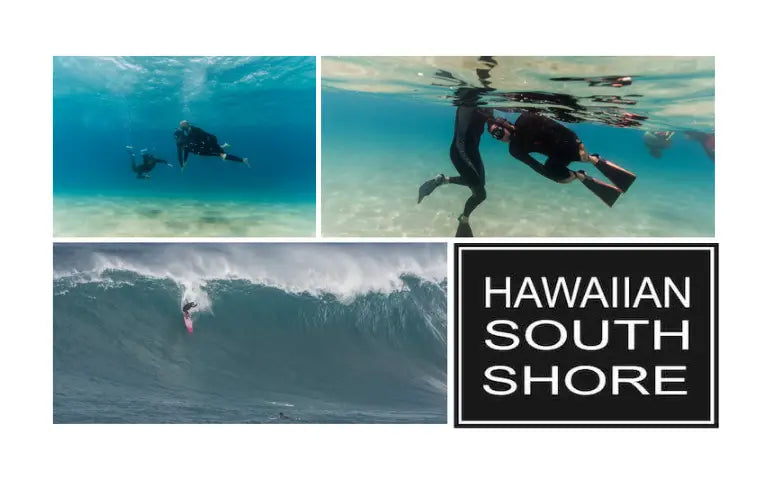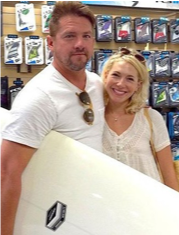Hawaiian South Shore March Newsletter
Share
RADIO TAISO AND A SURF AT KEWALOS
David Kelly | Owner, Hawaiian South Shore
The other morning when I was getting ready to surf, I heard some music playing. I looked around, and realized the music was coming from the docks. I could see a group of people doing calisthenics, and it appeared that they were doing it in time to the radio music! This reminded me of when I was growing up in Okinawa. Every morning during summer break at 6:30a.m., we would all line up at the community center (“kominkan”) and do something called radio taiso (“radio exercise”). We would follow along with this radio program, doing calisthenics as directed by the broadcast. Afterwards, we would have little report cards that would be stamped and have some comments added into them; then we would go on our way. After we completed all the classes at the end of summer, they would give each kid prizes for attending. From what I understand, many local businesses help sponsor the morning exercise with gifts. I think it’s a really cool idea, it prompts kids to learn responsibility and rewards them in the end.
It definitely helps kids start their day early and maybe gives them some incentive to get their summer homework done early…yes, Japanese kids have daily homework assignments during their summer break. It’s structured to give them daily discipline so they can enter the work force as responsible adults. As it turns out, radio exercise didn’t start in Japan—it started in the US in the 1920’s. Metlife sponsored a 15-minute radio calisthenics program that the public could follow along to. The program never became very popular in the US, and eventually faded out. But some visiting Japanese postal insurance workers witnessed this activity and took it back to Japan, where it became quite popular. In 1952, Japan’s national radio started a radio taiso program. It became

a daily activity for practically the entire population until around the time of World War II.Today, radio taiso is still widely practiced in schools all around Japan. It serves as a warm-up for
physical education classes, and also as a way to start big events. Some companies also still encourage daily radio taiso sessions for their employees—and I think that must be what I observed happening at Kewalos the other day! It’s fun to see how culture spreads from place to place, and how some things fade out while others remain popular. It’s pretty crazy to think that I used to do daily radio taiso decades ago as a child in Japan, and years later I saw a bunch of people doing it in downtown Honolulu! I guess that just goes to show the power of tradition, and the importance of exercise!
A CHAT WITH HAWAIIAN SOUTH SHORE MANAGER, BRETT MARTIN

Brett Martin is the Manager of Hawaiian South Shore, and more often than not he is the smiling face you see behind the counter when you come in for a visit. Whether you are looking for a new board, a bar of wax, or just some friendly advice; Brett is the guy to talk to. This is why we want to help our HSS Ohana get to know him better through a series of interviews. This month, Brett tells us what inspired him to first move to Hawaii, and how the move impacted his life.
Q: So, Brett, why did you first decide to move to Hawaii? A: Well, to be honest, I had an opportunity and I took it! My brother lived here, so I had a place to stay. I also had some money saved up, so I could afford to be out of work for a month or so. Plus, I had just completed my bachelor’s degree, so I no longer had school- related obligations like exams and papers. I felt it was time to experience a completely new environment. I had barely traveled at all, outside of where I grew up in California. In fact, before I moved to Hawaii I had never even been on a plane. Flying to Hawaii was my first plane ride ever! What better reason to take your first plane ride then to move to Hawaii, a tropical paradise with waves all year round? This is probably the closest I’ll ever get to my own endless summer. Even though I didn’t really have any job or career prospects lined up before the move, I just followed my heart, went for it and hoped for the best.
Q: Wow, what an adventure! But of course, you had found a job once you got here. What was your first job when you moved to Hawaii?
A: My first job was a Sales Associate at Old Navy Ala Moana. That was the first place to call me back after I applied. The job was only part- time, but I figured it was something at least. Meanwhile, I applied to other places in hopes of finding a more suitable full-time position that would better utilize my education and allow me to afford to find my own place to live, so I wasn’t such a burden on my brother (who was letting me stay with him at the time).
Luckily, I was able to transition into a full-time job at Old Navy. I got promoted to the management level pretty fast. Within four months I was promoted to a Pricing Specialist, which was pretty much leading a team that was updating prices and marketing. There was always a new sale going on at Old Navy, so there was plenty of work for me to do. I did really well in that position and ended up receiving a second promotion to Operations Manager less than a year later. Since I received an increase in my pay from the promotions, I was able to afford to move out of my brother’s place. It was perfect timing, because right after I moved out of his place, he packed up and moved back to California to pursue his dream of becoming a fire fighter. I really lucked out with my first job at Old Navy. I enjoyed it and I was able to grow there. The timing of everything (with getting promoted) couldn’t have been better! Sure, there were struggles and obstacles (as there are with all jobs), but I was able to overcome them and eventually earn enough to support my dream of living in Hawaii without having to juggle multiple part- time jobs in order to make it here. Plus, the experience that I gained in management prepared me for my job here at Hawaiian South Shore, which is basically my dream job!
MEMBER OF THE MONTH
Jeff Ho

Our customer of the month is Jeff, a surfer and martial arts practitioner who found his way back to health through activity. Jeff first started surfing in high school. He had moved to Colorado from Hawaii when he was five and snowboarded there. He also body boarded whenever he was back in Hawaii visiting, but never really got into surfing. Then around his senior year in high school he came back to Hawaii and started to surf a bit more. But life got in the way, and after moving away again for work, he eventually let surfing go.
In 2007, Jeff moved back to Hawaii for good. At the time he was 200 pounds—what he describes as pretty out of shape. But watching other people surfing made him decide he wanted to get back into shape and back in the water. He bought a board and dove backinto surfing, while at the same time exploring the Chinese martial art practice of bagua. He even went to China for a more intensive instruction in bagua, where he was adopted by his teacher and instructed not only in the physical movements, but also the principles of Taoism and non-action. The combined activity of surfing and bagua helped Jeff lose 40 pounds and get back to a healthy state. His blood pressure went down, he is stronger and more flexible, and he feels 10 years younger. That renewed energy has allowed him to keep up with his kids, who also practice bagua. In fact, the whole family practices, with his wife teaching the kids (according to bagua tradition, fathers are not supposed to teach their children, due to the fact that there are striking movements, and it can be difficult for children not to emotionally internalize strikes received from their fathers during martial arts practice.) Jeff finds that there are many parallels between bagua and surfing, particularly related to the philosophies of non-action using natural force and energy rather than trying to create your own. Working with nature rather than against it leads to more graceful and efficient movement. That comes in handy when Jeff is out at Diamond Head riding his new 5' 11" Cymatic that he picked up from the shop recently. The super-charged metabolism that results from surfing and practicing bagua also comes in handy when Jeff stops by Rainbow Drive-in for a post-surf meal! We always love when Jeff stops into the shop to talk to us about a story, and he enjoys the Hawaiian South Shore experience too. In this age of online shopping and Amazon, he says that it’s refreshing to be able to come into a shop where the staff knows you and connects with you on a person-to-person level. We couldn’t agree more and look forward to seeing you all in the shop sometime this month! Every surfer should take this class. Learn how to handle a whip out, hold your breath with confidence and learn what do when your surf buddy is in trouble.
APNEA SURF SURVIVAL CLASS

2 DAY COURSE $189 | June 22nd and 23rd | Text us: 808.400.4489
As surfers, we immerse ourselves daily in a huge natural expanse that is infinitely larger than we are. The ocean is powerful and unpredictable. The inherent danger that it poses to our well-being is surely part of the appeal of surfing—it gives us a feeling of living on the edge. However, most of us probably don’t want to get too close to the edge. Instead we want to get a little taste of adventure, and then still make it home safely. In other words, we might paddle out when the waves are big and scary, but we don’t necessarily have a death wish. One of the best ways to ensure that you make it safely to shore after a heavy session is to be confident in your abilities as a waterman or woman. This of course includes paddle strength and ocean awareness, but it also includes the ability to remain calm under duress, and to hold our breaths long enough to survive big hold downs. Ricardo’s apnea and surf safety class involves coursework, dry-land instruction and exercises, and water instruction and exercises. We will be hosting a two-day class at Hawaiian South Shore on June 22nd and 23rd. The dry-land portion of the class will be held in our shop on the 22nd, and the water instruction will be held at Ala Moana Beach Park on the 23rd. While the water instruction won’t be quite as intense as what Ricardo offers to his lifeguard and pro surfer students, most people will still be able to hold their breaths for at least two minutes by the end of the course. One of these great benefits of this apnea and surf safety course is the fact that everyone who attends is welcome to attend any future apnea courses that Ricardo teaches for free. In other words, you can brush up on your skills and improve your comfort in the water as many times as you want, but only have to pay one time (the two-day course costs $189 plus tax!) After doing this course last year, I can say with confidence that it has helped me improve my comfort and competency in the water. It has made me a better surfer, and the knowledge that I gained through the course is something that I take with me every time I paddle out. I’ll be doing the course again this summer and hope you will too!
YOGA FOR SURFERS: RECLINED DOUBLE PIGEON POSE

As surfers, we tend to do a lot of repetitive motion and spend a lot of time in certain positions that can create imbalances in our bodies. Two of these—the arched-back paddle position and standing on a board with our feet perpendicular to the stringer (often with the majority of our weight and power on our back foot, and with our front foot turned ever so slightly forward)—create tightness and imbalance in our hips. This can affect our ability to surf and do other activities well, and also contribute to lower back pain. Thus, it only makes sense that surfers should spend a bit of time every day loosening up our hips and ensuring that they are flexible and healthy. Our monthly yoga pose does exactly that and should become a part of your daily routine. Five minutes in the morning and evening will do wonders for your hip flexibility—and you might as well do five minutes on the beach before you paddle out as well. It’s a relaxing pose, and nothing gets you in the mood for some waves like lying in the sand! Supta aginstambhasana (also known as reclined double pigeon or reclined fire log pose) is a passive stretch that allows gravity to do most of the work- but this doesn't mean it's easy. Prepare for the pose by lying on your back and getting comfortable. Do some deep, focused breathing to get yourself settled, both physically and mentally. Then hug your knees to your chest and pull them toward you with your arms. Rock back and forth along your spine a few times until you come up to a seated position. Start in a simple cross-legged seat. Then, with the help of your hands slide your left ankle on top of your right knee/thigh so that your lower left leg is stacked on top of your lower right leg. Make sure that your left ankle does not settle into the crease of your right knee—it should almost feel like your left foot is hanging off the side of your right thigh. With your legs in this position, slowly lie down on your back and breathe deeply. If you have any knee concerns (such as medial meniscus or MCL injury), move carefully and cautiously. This pose, or any pose for that matter, is not worth reinjuring yourself. You can lessen the intensity of this pose in two ways:
- Roll up two towels separately, and prop one under each knee/thigh.
- Maintain the initial cross-leg shape with one shin set in front of the other, instead of stacked on top of each other.
You may find that your hips are quite tight, and that the legs cannot lie flat on top of each other. This is not a problem! We all have different bodies and levels of flexibility. Remember you only need to go as far as it takes to feel the stretch. Someone with more range of motion may need to go a little further, whereas someone with less range of motion doesn’t need to go as far to feel that sensation. No matter where you are on that scale, don’t forget to breathe steadily. The longer you stay in reclined double pigeon, the deeper you will feel yourself settling into this pose. You may feel a release in your hips, back, and buttocks, and find that your legs are gradually able to sink lower than when you began. Hold the pose for two minutes, breathing deeply and slowly the entire time. Then gently release the legs so that they’re both extended out on the ground once again and repeat the pose with the other side (left leg under and right leg over). Once you’ve done both sides, return to shavasana (corpse pose), return to shavasana (corpse pose), which is simply lying on your back with your legs extended comfortably on the ground. Close your eyes and breathe deeply as you feel the spaciousness in your hips. Take a few more breaths as you consciously focus on softening all of the muscles in your body, starting at your feet and moving up toward your head. Then, once you are fully relaxed, slowly roll to one side and use your hands to press yourself up to a sitting position. From there, you are ready to start you day, paddle out for a surf, or crawl into bed- it all just depends on what you have planned after your stretch! Kilty Inafuku teaches yoga classes on the North Shore (at the North Shore Yoga Co-Op and Paumalu Yoga), in Honolulu (at Power Yoga Hawaii Piikoi), and in Kailua (at Yoga by the Sea). She also hosts and guest teaches at various yoga events on the island and leads retreats both in Hawaii and overseas. For more information, visit www.kiltyyoga.com.
GETTING TO KNOW CLIFF KAPONO: VISSLA'S MAN OF MANY ROLES

Over the years, surfing has had a wide variety of characters, ranging from chargers and contenders to kooks and clowns. While these luminaries have worn numerous coats as surfers, shapers, documentarians, and innovators, true renaissance men have been few and far between. But Hawaii currently has a true renaissance man in its ranks, a surfer who brings together academia, philosophy, environmentalism, innovation, athleticism, and marketability.
Clifford Kapono grew up on the big island and comes from a respected Hawaiian family. While he was a talented surfer growing up, his family emphasized the importance of education. After graduating from Kamehameha High School, Cliff earned an undergraduate degree, then decided to pursue post-graduate work. He eventually ended up at Scripps in San Diego, where he earned a PhD in chemistry while dominating local breaks such as Blacks Beach. In the process, he gained a lot of attention as an environmentalist, and started the Surfer Biome Project, where he tested surfers’ poop to assess the bacteria present in our bodies and whether there are any similarities between us.
When Cliff finished his PhD, he wanted to find a way to bring his message of environmentalism to the surf world at large. He already had an audience with the academics but needed a way to reach young people who didn’t naturally gravitate to scholarly journals. That opportunity presented itself when Vissla picked Cliff up as a team rider. Cliff rips on just about anything, styling on logs and alias, charging huge Jaws and Mavs, steezing through slabby pits and boosting airs at will, so he was a natural fit for the free-thinking Vissla family. But he also continues his work as a scientist, writing grants and doing lab work that ranges from bacterial testing to reef mapping to gene splicing and environmental studies. At the same time, Cliff has joined the faculty at UH, and will be teaching surf-themed, environmentally focused classes there this year.
Cliff’s career as a professional surfer has really taken off over the past few years. His surf edits regularly pop up on the major websites (such as Stab, Magicseaweed, and Surfline), he was recently profiled by The Surfers Journal, he is quoted and featured in practically every environmentally themed surf article that is released and was recently invited to Kelly Slater’s Surf Ranch to consult with the WSL and the environmental arm of their corporation. But for all the fanfare, Cliff is a humble, thoughtful, unassuming local boy who simply wants to score fun waves with friends, bring the people of Hawaii together, and make a positive difference in the world. He splits his time between Big Island, Maui, and Oahu, where he spends time with his girlfriend, who is also a PhD scientist, Hawaiian cultural advocate, world-class long boarder, and navigator on the Hokuleia.
Next time you are on the shoulder at Pipe and see a crazy-haired Hawaiian in Vissla shorts rolling in to the second reef or paddling out at Bowls and see him perched on the nose of a 10' 6' log- throw Cliff a shaka and talk a bit of story. You aren't likely to find a more friendly guy in the water.
JS BLACKBOX3 SWWALLOW TAIL IN HYFI CONSTRUCTION
JS Industries has been a leading surfboard brand for years, and their recent HyFi technology has taken JS boards to the next level. This innovative epoxy construction combines the best of durability, flex patterns, responsiveness, and light weight to create boards that simply perform better. The lively feel of the boards is miles ahead of other epoxy constructions and is actually preferred by many pros who typically only like the feel of PU. The strength and ding- resistance of the boards seem almost counter-intuitive when you feel how light they are; which is exactly what makes this construction process so special. JS has been slowly expanding their inventory to include more models that feature the HyFi construction. Here at Hawaiian South Shore, we are excited about the fact that we will be the first retailer in the world to carry the BlackBox 3 Swallow Tail in HyFi. The BlackBox 3 is one of JS’s most popular designs, and has been recently revamped for softer, weaker waves, making it a great shred- stick for when conditions are a bit sub-par. Additional planning area in the nose and added foam under the chest adds speed, while the wide point has been moved forward and combined with a swallow tail that creates a straight rail for more down-the-line speed and drive. This board is a great daily groveler for the average surfer, or a good step-down for pros looking to spice up their performance in below-average waves. We have been excited about the BlackBox 3 Swallow Tail ever since the new design was released and ordered a bunch for the shop awhile ago. Since making our order, JS has been convinced to release the board in the HyFi construction, and we will be the first shop ever to receive these upgraded boards. With the latest groveler shape in the best, most high-tech epoxy construction on the market, the BLackBox 3 Swallow Tail in HyFi is the ultimate summer board- and summer is just around the corner!

The Firewire Seaside's are blowing up. Here's Joy with her new 5' 4". I'm sure she'll be ripping it up park side.
Joe picked a CJ Nelson 9' 6" Sprout he rode it and he was so stoked to pick up a 10' Sprout Carbon/Inegra too.

Our good friend Zachary Knighton who stars on Magnum PI as "Rick" stopped in and grabbed himself a 8' 3" CJ Nelson Colapintail. He's actually been eyeing this board for a few months. He has a CJ Classic and a CJ Sprout which was used in a few scenes on Magnum PI. He demoed our 8' 3" and he said if the show gest approved for another season, he's going to get this baby...and what do you know...they are here for another season. Super stoked for him and the crew. Rose on the ABC comedy series Happy Ending, in 2007. He also starred in the horror film remake, The Hitcher.


